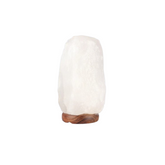Fire Safety with Himalayan Salt Lamps: Best Practices
Fire Safety with Himalayan Salt Lamps: Best Practices
Himalayan salt lamps are valued for their warm glow and calming presence, but like any electrical appliance, they come with safety considerations. Over the years, reports of overheating, electrical faults, and even rare fire incidents have raised concerns about whether these lamps are truly safe to use. The good news is that when used properly with the right bulbs, safe wiring, and basic fire safety precautions salt lamps are no more dangerous than any other household light.
This guide explains how to ensure your Himalayan salt lamp is safe, how to comply with UK electrical standards, and what practices reduce the risk of fire hazards in your home.
Why Fire Safety Matters with Himalayan Salt Lamps
A salt lamp consists of a hollowed-out block of Himalayan salt fitted with a light bulb, cord, and holder. While the salt itself is non-flammable, risks arise from the electrical components.
Key risks include:
- Overheating bulbs that can scorch holders or wiring.
- Faulty cords or loose connections leading to sparks.
- Moisture exposure (salt is hygroscopic, attracting water from the air) which may corrode electrical parts.
- Poor-quality imports that fail to meet UK electrical standards.
Understanding these risks is the first step toward safe usage.
Choosing the Right Bulb for Fire Safety
One of the most common causes of overheating is using the wrong bulb. Salt lamps are designed to run with low-wattage bulbs that generate gentle warmth, not excessive heat. If you’re unsure how to safely switch bulbs, follow a step-by-step approach to replacing bulbs in Himalayan salt lamps to ensure both proper fit and fire safety.
- Recommended bulb type: E12 candelabra bulbs, 15W to 25W, designed for small appliances.
- Avoid high-wattage bulbs: Anything over 40W can cause the lamp’s holder to overheat.
- LED alternatives: While they produce less heat, they also don’t provide the same moisture-reducing warmth that traditional bulbs do.
Tip: Always check the lamp’s rating label before replacing the bulb to ensure wattage compatibility.
Inspecting Wiring and Electrical Components
Faulty or non-compliant wiring is the leading cause of salt lamp fire hazards. Since many lamps are imported, it’s important to confirm whether they meet UK electrical standards.
Checklist for safe wiring:
- Plug safety: Ensure the plug is BS 1363 certified with a fitted fuse.
- Cord condition: Look for cracks, fraying, or stiffness replace immediately if damaged.
- Switch placement: Switches should be easy to access and away from salt surfaces.
- Secure bulb holder: Loose fittings may cause electrical arcing.
If your lamp does not have a CE or UKCA mark, it may not meet required safety standards and should not be used.
Placement Matters: Safe Locations for Salt Lamps
Where you place your Himalayan salt lamp plays a crucial role in fire safety.
- Stable surfaces: Prevent tipping, especially if the lamp is heavy.
- Away from fabrics: Keep clear of curtains, bedding, or paper that could ignite.
- Dry areas: Do not place near humidifiers, bathrooms, or kitchens where moisture exposure is high.
- Child safety: Avoid placing within reach of children or pets to prevent accidental burns or electrical hazards.
Maintenance and Ongoing Safety Practices
Routine care can prevent long-term hazards:
- Keep lamps on when possible: Running the lamp reduces moisture buildup on wiring.
- Regular inspections: Check bulbs, cords, and holders monthly.
- Replace damaged parts immediately: Never use makeshift fixes like tape or glue.
- Unplug during storms: Protect from power surges that could cause electrical damage.
Fire Safety According to UK Standards
In the UK, electrical appliances must comply with safety regulations. For salt lamps:
- UKCA/CE certification ensures compliance with essential safety requirements.
- Fused plugs are legally required; unfused imports are unsafe.
- BS 1362 fuses must be used in plugs for fire protection.
If you are uncertain, consult an electrician or purchase only from reputable UK-based suppliers who meet these standards.
People Also Ask: Salt Lamp Fire Safety FAQs
Can a Himalayan salt lamp catch fire?
Not the salt itself, but faulty electrical components or overheating bulbs can create fire risks.
How do I know if my lamp is safe?
Check for UKCA/CE certification, fused plugs, and proper wiring. If any part feels hot to the touch, unplug immediately.
What’s the safest bulb to use?
Low-wattage E12 bulbs (15W–25W) are ideal. Avoid high-wattage or non-recommended bulbs.
Can moisture cause a fire?
Moisture doesn’t ignite salt, but it can corrode wiring, leading to short circuits. Keeping the lamp in a dry, ventilated space prevents this.
Final Thoughts: Safe and Peaceful Use
Himalayan salt lamps can be a safe addition to your home if you follow simple fire safety precautions: use the correct bulbs, inspect wiring regularly, and ensure compliance with UK electrical standards. By choosing quality products and maintaining them properly, you can enjoy the gentle glow of your lamp without worry.
For further reading, see our safety cluster guide on overall salt lamp precautions.





